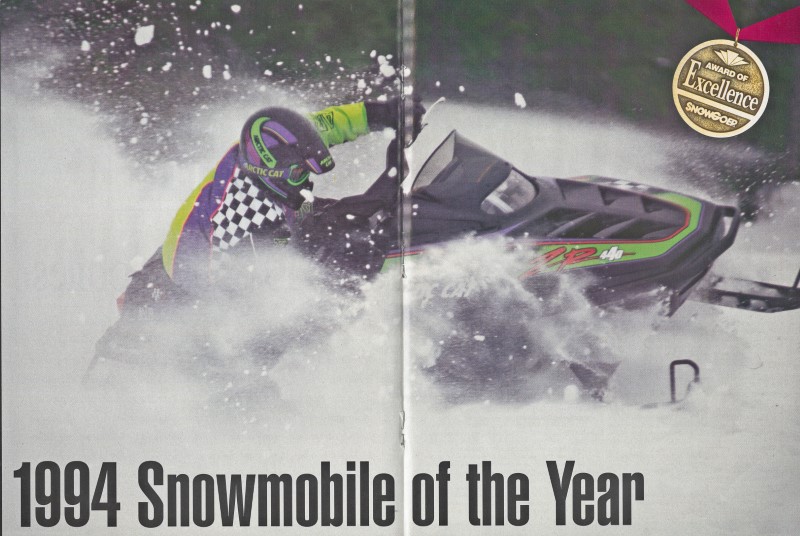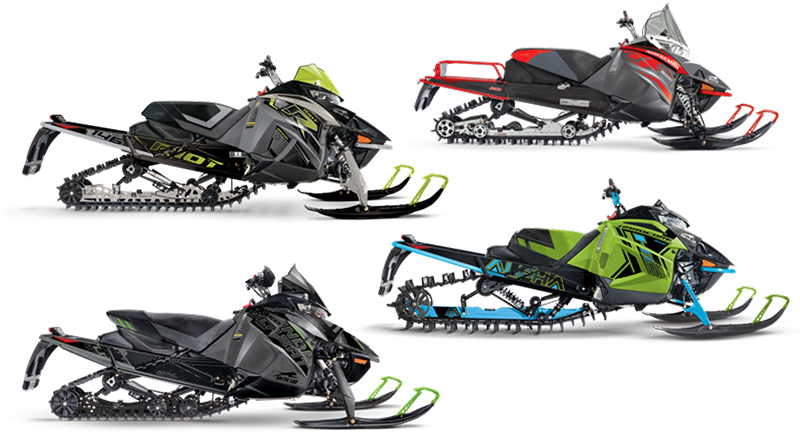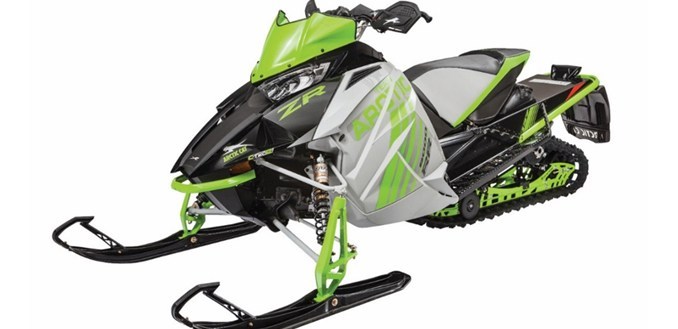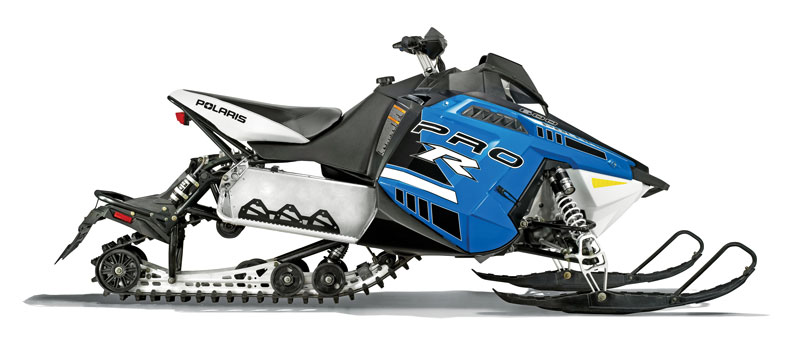 The 2010 Arctic Cat snowmobile lineup includes snowmobiles that suit the needs of nearly all snowmobilers – from the Sno Pro 500 for ditchbangers, racers or racer wannabes to the CFR and Z1 Turbo models for speed freaks who get their kicks zipping across a lake. Cat’s fleet also includes an updated line of M Series sleds for mountain riders, not to mention time-tested hybrid sleds for Midwest powder riders plus a group of luxurious solo and 2-Up touring machines for people who ride for relaxation instead of an adrenaline rush.
The 2010 Arctic Cat snowmobile lineup includes snowmobiles that suit the needs of nearly all snowmobilers – from the Sno Pro 500 for ditchbangers, racers or racer wannabes to the CFR and Z1 Turbo models for speed freaks who get their kicks zipping across a lake. Cat’s fleet also includes an updated line of M Series sleds for mountain riders, not to mention time-tested hybrid sleds for Midwest powder riders plus a group of luxurious solo and 2-Up touring machines for people who ride for relaxation instead of an adrenaline rush.
The Sno Pro 500 made headlines last spring because this will be the first season that Cat’s lightweight race chassis is available for consumers (a 600cc version first hit racetracks as a 2008 model). Does it represent the future of Cat’s performance lineup? It’s too early to know for sure, but for now, aggressive Cat riders will be pleased with the Sno Pro’s awesome handling and fully capable suspensions.
What you have a deep need for speed? Cat has you covered, too, with a line of two- and four-stroke snowmobiles that can easily eclipse the 100 mph mark. The official line from Cat about its new 144-inch Z1 Turbo EXT is that it’s for off-trail customers, but we know better: they wanted to give its turbo-boosted engine more traction. The CFR 800 has Cat’s new 800cc Suzuki with a claimed 151 hp. For our tastes, it’s the best and most playful engine you can get from Cat for 2010. Read more about it on page 40 where we compare the CFR 8 LE and F8 Sno Pro LE.
Like most other sleds in Cat’s lineup, the Crossfires have new skis that give a noticeable improvement in handling, but Crossfire buyers will also benefit from a half-inch wider design for better flotation. The HCR 800 comes back as a full-season sled (it was introduced last fall under a limited production). Built for free-riders who do more backcountry exploring than hillclimbing, it has an adjustable 42- to 44-inch ski stance for more stability and the new motor gives the sled more refinement.
LXR and T Series machines are built for comfort from the ground up. It starts with the Twin Spar chassis that might be the most comfortable on the snow, and gets better with factory-installed accessories. Our choice for a long day on the trail? The F8 LXR. The new seat with its detachable trunk bag and clean tunnel close-off panel is cleaner and more durable.
Hits
+ Revised tunnel close-off on Twin Spar models
+ Sno Pro race chassis
+ New skis
Misses
– Too much exhaust pipe noise
– Seats are too soft and slippery
– Vibration at idle
Intra-Brand Comparison: CFR 8 LE vs. F8 Sno Pro LE
You’re a Cat fanatic and you want an 800cc trail sled. Good for you, because the new 800 H.O. is the best engine to come from the Thief River Falls sled factory this year. Here we take a closer look at two solid choices from Cat this season: the CFR 8 LE and the F8 Sno Pro LE. The LE designation means the sled received special graphics and color treatment; mechanically, they’re the same as F8 Sno Pro and CFR 8 counterparts. They were available as limited edition models last spring, but chances are you’ll be able to find one at a dealer.
What’s The Same?
About all that the CFR 8 LE and F8 Sno Pro LE share is their engine. The 800 H.O. is a nearly all-new motor that is “pushing 155 hp,” Cat said last spring. The Suzuki it replaces was good for about 145 ponies. The crankshaft is more than 4 pounds lighter with new pistons, head and cylinders. Calibrations for the fuel system and Arctic Power Valves have been re-worked for more power and efficiency.
What’s Different?
The CFR is based on the M Series chassis that was originally built for lightweight, deep snow performance. While still a lightweight, the CFR is now a purpose-built lake racer or trail carver. The F is built on the Twin Spar chassis that came out in 2007, and has since been massaged for sharper handling, more comfort and better performance that make it an excellent trail sled.
Behind The Bars
This new engine gives new life to Cat’s 800 class machines (it’s in M Series and Crossfires, too). With great power in the mid range, engineers built an engine especially for fun corner-to-corner acceleration. Strong mid- and low-end performance generally translates to less speed on the top end, but based on a few chances we had to stretch the CFR and F8’s legs, these Cats are fast up top, too. We’d give the edge to the lighter CFR with the 14-inch wide track, and the chassis rolls easier than F8. The CFR coasted through corners easier and it didn’t slow down as quickly when letting off the throttle.
The CFR 8 LE is for you if you want more speed and sharp handling. The CFR is for a sit down rider who has luck on his side to encounter smooth trails. Big bumps tax the suspensions, so riders will just have to grin and bear it if they get into a stretch of rough trail. The machine handles well and corners flat on smooth trails, and those two traits along with a great new engine make it an excellent sled for slinging through the woods. Knowing the new skis — with stiffer, deeper keels — are up front gives a driver confidence that the machine will stick in the corners. And if you think you won’t make a corner, the brakes stop the sled in a hurry. Whether accelerating out of the hole or launching out of a corner, the chassis has good weight transfer that’s predictable and controllable. The balance feels right. The footwells are too shallow for a driver to connect with the sled, so we never felt like we could work as a unit with the machine. A taller seat would help the ergos as it would let the driver sit up and reduce the bend in his knee.
Buy the F8 Sno Pro LE if you want a better ride and log 200-mile days. This is a solid, all-around good performer and a pleasure to drive. It proved to be the better choice on rough trails because it absorbed bumps without bottoming. Shocks aside, the Slide Action rear and AWS VII front provide a more comfortable ride. It’s way ahead in comfort, not only in ride quality, but also in how the sled feels and fits your body. There’s plenty of room in the cockpit with ergos that are better than the CFR for side-to-side transitions or when going from attack mode to a relaxed position. You won’t be distracted by shallow foot wells or a seat that’s too low. The F8 is planted on the trail and the machine is more stable than the CFR in many conditions. The F8 has more ski lift than the CFR, but it handles nicely. Handling is improved over earlier F’s because of the new skis. The F8 required minimal steering effort, but it pushed in corners when under acceleration or on ice pack or hard pack (this can likely be tuned out with adjustments or aggressive carbides).
Engineer Q&A Sno Pro 500
Troy Halvorson, 42
Arctic Cat Performance Team Manager
Arctic Cat’s reputation is that of performance, and the company’s new Sno Pro 500 is built upon that legacy. We talked with Troy Halvorson, Cat’s performance team manager, to find out how the snowmobile went from the race track to the trail for 2010. This is an excerpt of our interview with Halvorson. For more inside information on how engineers developed the Sno Pro, go to snowgoer.com.
How did the Sno Pro 500 come about? When did Cat start on the project?
“It started as a race sled built specific for racing, and we wanted to apply [it] to a consumer sled eventually. We worked hard on getting weight down and keeping strength and the ergonomics we were looking for. We had a really good second year with the race sled [last season] and we knew consumers would really like to see it as a trail sled.
We looked toward the 500 EFI as something with less work to put in there because of the [physical] size of it.”
How long was the Sno Pro race chassis in development?
“After the Firecat [came out] and they started working on the F Series, [we] spawned off and had a group that just worked on the race sled. After the F Series got going, we needed a new race sled, so we started working on it a couple years before it was released. You start with a prototype, then proof of concept and then to design. It normally takes three to four years. This race sled was actually at two years. We had a good group of guys. [Suspension engineer] Brian Dick worked on it pretty hard with help from [race manager Dan] Ebert and Kirk [Hibbert]. When you can focus on not having to put electric start, oil injection, etc, you can make a lot of progress pretty quickly when the priority is for it to be what you’re going to race.”
Why the 500 engine and not a 600 that consumers are clamoring for? Do most riders even need more than 500cc?
“We wanted a [top-performance] sled that a consumer can buy without spending $10,000. I was running the 500 against the guys with the 600s [last winter]. No, it’s not as quick, but it’s nice because you can ride it to its limit without getting into trouble. If you’re running corner-to-corner, that 500 works awesome. Yeah it’d be nice if it had 20 more horsepower, but they’ll have a blast racing against each other. You can have fun on a less horsepower model if it’s lightweight and a good chassis.”
What’s the first thing a person will notice about the sled when he or she takes a new Sno Pro 500 down the trail for the first ride this winter?
“He’s going to notice how comfortably he can get adapted to it quickly Anybody who likes to ride aggressive is going to be comfortable right away. It’s going to feel like you’re ready to go race right off the bat.”
You’ve spent a lot of time riding this chassis. What is its greatest attribute?
How you can get just move around and get in a good crouch. The big thing is our steering system is so nice to steer. You can go to a deeper-keel ski and … corner really well with less upper body strength. One thing we wanted to make sure is to not skimp on the suspension. We feel really good as far as durability, transfer control and bump absorption. Kirk was told, ‘Put together a package that’s not going to tear you up but be able to take the bumps.’ You don’t have to go 80 mph to make the suspension work.”
The skidframe spec has changed since we first reported on this sled last spring. Talk about the changes and why they were made.
“This suspension is right from the race sled. There are slight differences from the F [Series] to this sled like no torque-sensing link, little nitty-gritty differences. The gist of it is we wanted a suspension that a guy could race without durability issues. We wanted to give it everything it needs to go racing.”
What was the biggest hurdle for engineers to make this machine a reality?
“Probably the biggest was the time it takes to develop the EFI map and exhaust system. Criteria was that it had to meet the same horsepower and emissions as the current 500 we have [in the F5] even though this sled has a different airbox and muffler. It requires a guy to spend a season to develop it, time to map it. That whole process takes a good amount of time.”
Cat built this sled to help grow snocross and cross-country racing. Talk about why snowmobile racing is so important to Arctic Cat.
“You can look back, and some of the early photos of when Cat started … racing has always been a big deal. You could really blame it on Roger [Skime, Arctic Cat vice president of research and development]. I think there’s a racer in everybody. Even the people who just ride touring sleds … envision themselves racing. And it’s a fun product and it lends them to thinking, ‘Who’s going through the woods the fastest?’ When snowmobilers see a sled racing, the better their brand of sled worked on the track, the more confidence they have in their machine.”
Does this platform have a future in Cat’s lineup?
“The things that we learned and that we like are definitely going to carry over into the consumer market. We’re getting to the point that what we learn on the racetrack will carry into the consumer sleds.”
ADD’L WEB CONTENT
Arctic Cat Performance Team Manager gave us so much inside information about the Sno Pro 500 that we couldn’t fit it all between the pages of our season premier issue of Snow Goer magazine. Here is the interview in its entirety.





